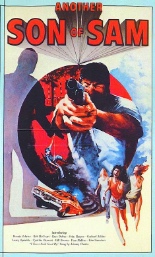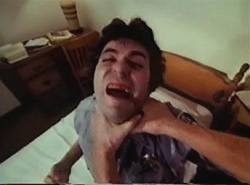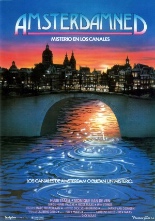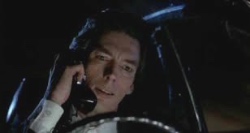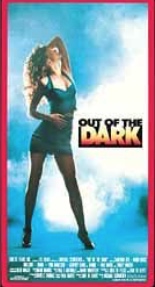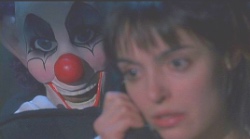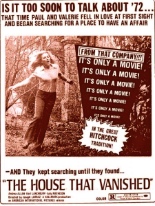
 As many glamorous models do, Valerie (Andrea Allen, Old Dracula) exhibits terrible taste in men; her boyfriend, Terry (Alex Leppard, Crowley), is a two-bit thief whose idea of a date is taking Valerie with him to a remote mansion in the woods … and ordering her to stay in the car while he goes for a little B&E. Bored, she disobeys and joins him. Inside the house, the two have to hide in a closet upon realizing they’re not alone. From their vantage point, they watch in terror as a busty prostitute (Barbara Meale, Sex and the Other Woman) is brutally murdered by a man they cannot see, beyond the genre-appropriate black leather gloves covering his grabby, stabby hands.
As many glamorous models do, Valerie (Andrea Allen, Old Dracula) exhibits terrible taste in men; her boyfriend, Terry (Alex Leppard, Crowley), is a two-bit thief whose idea of a date is taking Valerie with him to a remote mansion in the woods … and ordering her to stay in the car while he goes for a little B&E. Bored, she disobeys and joins him. Inside the house, the two have to hide in a closet upon realizing they’re not alone. From their vantage point, they watch in terror as a busty prostitute (Barbara Meale, Sex and the Other Woman) is brutally murdered by a man they cannot see, beyond the genre-appropriate black leather gloves covering his grabby, stabby hands.
A horrified Valerie hightails it outta there. The next day, Terry’s car shows up, but Terry himself does not. Nor does he later, and given the circumstances, it’s not exactly the kind of disappearance she can report to the police. In an attempt to locate him, friends accompany Valerie to the scene of the crime … if only she could find it. Why, it’s as if they’re looking for The House That Vanished.
 That title is a bit of a ruse, as House does not reside in the realm of the supernatural, where so many of director José Ramón Larraz’s best-known works do, including Black Candles and Vampyres, to name only two. That’s not to say he’s out of his element, but with the Spanish filmmaker shooting British actors in British locations, one could make the case that screenwriter Derek Ford (Don’t Open Till Christmas) possesses a greater claim of authorship. In Larraz’s favor, The House That Vanished noticeably bears a dominant stamp of suspense, although hardly “in the great Hitchcock tradition” shouted by its ad campaign.
That title is a bit of a ruse, as House does not reside in the realm of the supernatural, where so many of director José Ramón Larraz’s best-known works do, including Black Candles and Vampyres, to name only two. That’s not to say he’s out of his element, but with the Spanish filmmaker shooting British actors in British locations, one could make the case that screenwriter Derek Ford (Don’t Open Till Christmas) possesses a greater claim of authorship. In Larraz’s favor, The House That Vanished noticeably bears a dominant stamp of suspense, although hardly “in the great Hitchcock tradition” shouted by its ad campaign.
However, if you want to talk Hitchcock blondes, Allen is as functional as Tippi Hedren and as gorgeous as Kim Novak. Vanished (also released under the nonsensical and overly punctuated title of Scream — and Die!) gives her nearly every frame to fill, which she does with considerable allure and enough aplomb. Her Grace — er, grace — makes up for deficiencies elsewhere, such as a herring so red, it’s sunburned. —Rod Lott

